Outdoor Warning Siren History
The history of outdoor warning devices in Sedgwick County, today more commonly referred to as “tornado sirens,” begins with the end of the Second World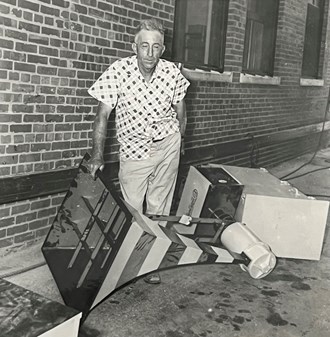 War, and the start of the Cold War. As tensions with the Soviet Union seemed to rise every day, and the threat of nuclear attack seemed to grow more and more real, Civil Defense (CD) offices started to become part of local governments across the nation. They were formalized and given standardized rules with President Truman’s signing of the Federal Civil Defense Act of 1950.
War, and the start of the Cold War. As tensions with the Soviet Union seemed to rise every day, and the threat of nuclear attack seemed to grow more and more real, Civil Defense (CD) offices started to become part of local governments across the nation. They were formalized and given standardized rules with President Truman’s signing of the Federal Civil Defense Act of 1950.
In 1952, the push intensified to install air raid sirens throughout Wichita and Sedgwick County. In April of that year, CD acquired from Federal Enterprises (later Federal Signal) what was referred to as a “test siren,” and mounted it atop Roosevelt School at 2200 E Douglas, on April 21, 1952 (the original building still stands, but is now part of East High School).
The next day, Tuesday, April 22, 1952, at 3:30 p.m., the first-ever air raid siren test in Wichita was conducted using this device. The expected range of the siren was 1.25 miles. Patrol cars and CD volunteers with decibel meters were spread out at various distances in five different directions surrounding the siren.
After directional tests along each of those five compass points, the siren was allowed to rotate and wail with its rise-and-fall air raid tone for three minutes. After two minutes of silence, the siren sounded the “all clear” with a steady tone for one minute. The main purpose of this test was to determine just how far the sound would carry. Twelve more sirens were being ordered, and CD would use the results of this test to determine how and where those devices would be installed to establish Wichita’s first siren network.
Not surprisingly, there were mixed results and reactions after the test. Newspaper coverage said citizens southeast, northeast and due east had no trouble hearing it within the expected range but were not certain they would have been able to tell the difference between it and a police or fire siren. West of the siren in downtown Wichita, it appeared the siren was not heard as well as had been hoped.
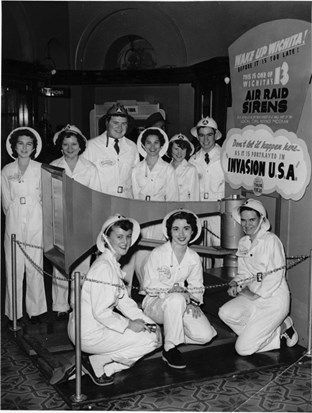
One amusing anecdotal account of success came from a man who happened to be walking past the school when the siren sounded. He immediately followed the “Duck and Cover” instructions by throwing himself into the gutter and pulling his topcoat over him. He told the reporter afterwards he was familiar with Civil Defense literature, but did not follow the local news, so he was unaware it was a scheduled test.
An article in June of 1952 reported that CD would begin installing the 12 new, permanent sirens on July 1. For unknown reasons, this would not happen until more than a year later. The installation of the first two permanent sirens wrapped up on July 14, 1953, with 10 more installed over the next few weeks. Along with the original siren at Doulas and Grove, Wichita and Sedgwick County’s original 13-siren network was laid out as follows:
- Atop the General Mills elevator, 430 E 18th *
- Planeview Community Building, 3735 E Ross Parkway*
* These two reportedly were installed on 7/14/53; the exact dates & order for the rest were not recorded
- Wichita Water Treatment plant, 1815 W Pine
- Santa Fe Railroad Shop, 1300 S Hiram
- Christ the King School, 4501 W Maple
- Arkansas School, 3300 N Arkansas
- Gardner School, 1926 S Ida
- Roosevelt School, 2200 E Douglas – it is unclear if they kept the “test” siren installed in 1952 or replaced it with a permanent model.
- Wichita University Commons Building, 17th & Fairmount
- Murdock School, 670 N Edgemoor
- Atop the AT&T building, 154 N Broadway
- 54 Drive-In Theater, Kellogg & Rock
- Hilltop Manor maintenance building, 1329 S Terrace
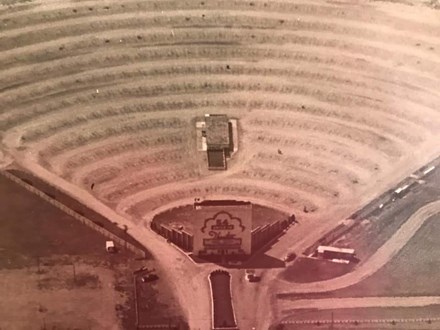 All of these sirens were Thunderbolt model T-1000’s, purchased from Federal Signal in Chicago. While most have since been replaced, and in some cases moved to new locations, three of the original 13 actually remain in operation (as of Aug. 2021). Because Federal used a simple, sequential serial-numbering system, stamped on its sirens as they came off the line, civilian siren enthusiasts, who have mapped the location of every Thunderbolt siren in the country that still stands, have confirmed that these three are the oldest Thunderbolts in the United States (and presumably the world) still being used. Parts and pieces may have been replaced over the years, but a significant amount of original equipment remains.
All of these sirens were Thunderbolt model T-1000’s, purchased from Federal Signal in Chicago. While most have since been replaced, and in some cases moved to new locations, three of the original 13 actually remain in operation (as of Aug. 2021). Because Federal used a simple, sequential serial-numbering system, stamped on its sirens as they came off the line, civilian siren enthusiasts, who have mapped the location of every Thunderbolt siren in the country that still stands, have confirmed that these three are the oldest Thunderbolts in the United States (and presumably the world) still being used. Parts and pieces may have been replaced over the years, but a significant amount of original equipment remains.
Those three are: Serial # T-75 at Kellogg & Rock. After the drive-in was taken down in the 1970’s and moved across the street to the Eastgate Mall parking lot. Serial # T104, originally installed at Christ the King, now located at Douglas & Anna. And serial # T116, still in Planeview, but now behind Jardine MS at 3550 E Ross Parkway. You can just barely see T-75 installed on the top left corner of the 54 drive-in theatre.
The new 13-siren system was tested for the first time on Thursday, August 20, 1953, at 7:00 a.m., then again at 4 p.m. The Wichita Eagle reported the early test was “to catch as many people at home as possible,” and the afternoon test was “to try out the effectiveness of the system when city traffic is heaviest, and when downtown noise was at peak volume.” Those decisions were attributed to Mr. K. U. Benjamin, Chief of the Civil Defense warning branch. When asked if he was concerned about waking people up with such an early test, Mr. Benjamin replied he would “be more concerned if it doesn’t wake them up.”
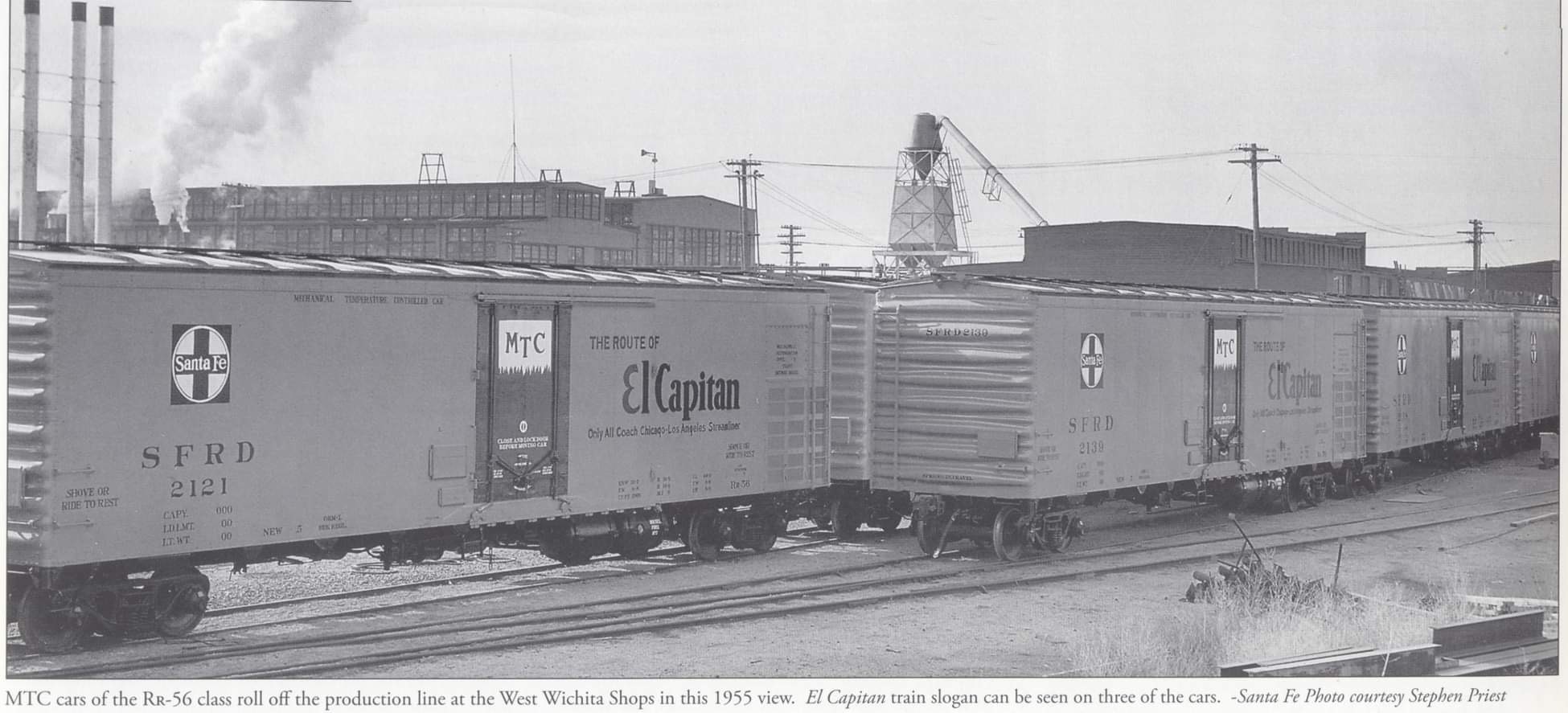
It is unknown what information about the pending test was shared beforehand with radio and TV, but the first mention in the newspaper about the 7AM test appears to be in the morning edition of the Eagle the same day as the drill. The evening edition of the Beacon newspaper that day had results of the morning test, and responses from citizens. The article termed the reaction as “immediate, vociferous and irate.”
Not surprisingly, many citizens were angry over being woken up at 7 a.m. for a test they had not expected. The newspaper reported on complaint calls received by Mayor Walt Keeler (presumably at home), the police department, the fire department, the sheriff’s office, and the Eagle switchboard, where they had so many calls holding that people hung up before their call could be answered. In addition to being upset at the early hour, many were confused because they had not been told a test had been scheduled.
As far as the system’s performance, CD Director Charles Bond termed the morning test a success, despite the fact that 3 of 13 devices failed to sound. The siren atop the phone building downtown, the one at Christ the King, and the one at Wichita U all were silent, but Mr. Benjamin promised to have them all working in time for the 4 p.m. test (there appears to have been no article with the afternoon results).
After August, the next time the sirens were tested was Friday, September 25, then not until Friday, Dec 18, 1953. No further information was published on the September test, but it was noted the one in December would take place at noon.
In a curious side note, a brief newspaper article on 12/31/53 said the city of Eastborough had installed a Civil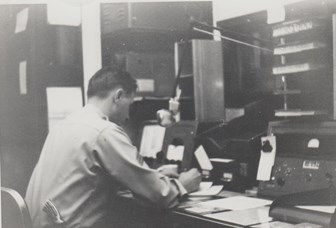 Defense siren at the west junction of Douglas & Huntington and would test it for one minute that night at midnight. Even though the Eastborough CD Director is quoted as saying they were cooperating with Wichita’s CD program, the Eastborough siren is never again mentioned by name in any of the research documents, and for the next five-plus years, all articles on the subject would refer to 13 sirens total in the county, not 14.
Defense siren at the west junction of Douglas & Huntington and would test it for one minute that night at midnight. Even though the Eastborough CD Director is quoted as saying they were cooperating with Wichita’s CD program, the Eastborough siren is never again mentioned by name in any of the research documents, and for the next five-plus years, all articles on the subject would refer to 13 sirens total in the county, not 14.
The next significant milestone in the history of the sirens would not take place until 1958. After a killer F5 tornado in 1957 leveled the Kansas City suburb of Ruskin Heights, officials in KC came up with a plan to use the Civil Defense sirens as part of a weather warning system during tornadoes. Wichita and Sedgwick County had fashioned a local plan based on the KC model, and at 9 a.m. on Tue, Apr 1, 1958, the 13 sirens in the county were sounded for the first time as a test of the weather warning alert plan. In addition to the air raid sirens (or atomic bomb sirens as they were sometimes referred to in print), the plan called for fire trucks and police cars to cruise through neighborhoods with red lights and sirens, announcing over their PA systems: “Take cover. Severe weather approaching. Do not use your telephone, tune in radio or television.”
The test would prove timely, as the system would be used for a real weather emergency just over two months later. Around 11 p.m. on June 11, 1958, the weather service in Wichita issued a weather wire warning to law enforcement of a possible tornado forming over east Wichita.
This was before 911, so the police sergeant assigned to dispatch duty that night, Paul Hansen, upon receiving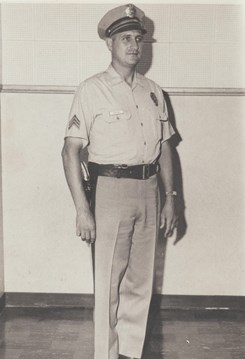 the alert, started calling the chain of command for authorization to sound the sirens. He first called the City Manager, and discovered he was out of town. Next, he tried the Public Works Director, but got no answer. At that point, using the authority granted by the plan, Sgt. Hansen hit the button that sounded the sirens around 11:05.
the alert, started calling the chain of command for authorization to sound the sirens. He first called the City Manager, and discovered he was out of town. Next, he tried the Public Works Director, but got no answer. At that point, using the authority granted by the plan, Sgt. Hansen hit the button that sounded the sirens around 11:05.
About that same time, a Wichita Police Captain authorized the sergeant to tell all squad cars to go up and down the streets with lights on, and sirens blowing; city fire trucks did the same. A tornado was reported near Kellogg & Rock at 11:08, and a second sounding of the sirens was authorized by the captain at 11:10.
A newspaper account indicates TV and radio eventually started broadcasting warnings directly from the weather bureau, but a resident at 2617 N Ida that suffered heavy damage told the Eagle they were watching TV and got no warning that way; they said it was the sirens that alerted them to the danger. She told how she and her husband barely got two children out of bed and moving to safety before the tornado destroyed their bedroom. City officials called the first real-world application of the sirens as a warning system a complete success and credited them with minimizing injuries and averting death.
A few days later, based on this success, and the city’s continued growth resulting in dead spots where sirens could not be heard, Wichita’s City Manager announced he wanted to use $50,000 in local funds, and another $50K match from the Federal government, to purchase 20 more sirens…but that did not happen.
It was not until a year later that we find the first verified expansion of the CD siren system beyond the original 13; in early June 1959, the 14th siren in the county was installed at Central & Tyler. And, with the devices now counted on to be “tornado sirens” in addition to their air raid duties, on June 8, 1959, Civil Defense began weekly testing of the sirens every Monday at noon.
In 1961, the system expanded again, this time to 21 sirens. This also appears to be the first time something other than Thunderbolts were installed, as CD requested two rotating, and five non-rotating, horn-cluster sirens. The latter was likely the Federal Signal model 2T22. They were cheaper than, but also less effective than, the T1000’s. The installation sites picked for these seven were: South High; McLean School, 2277 Marigold Ln; Fire Station 2, Bayley & Broadway; Bert Wells school, 3601 S Pattie; Jesse Hunter Black School, 1045 N High; Ingalls School, 2316 E 10th; and the new County Fire station at Central & Webb. With the weekly tests becoming commonplace, and their use during weather warnings, citizens were growing comfortable with the “tornado sirens.”
Then in 1962, Sedgwick County, and the nation, were reminded just why they had been installed in the first place.
In October of that year, international tensions were at an all-time Cold-War high due to the Cuban Missile Crisis. As Kennedy and Khrushchev stared each other down, Civil Defense authorities made the decision to suspend the weekly Monday test. They did not want to risk a panic, and they wanted to avoid any possible confusion over why the sirens were sounding. The sirens remained silent the rest of fall and into winter; weekly testing would finally resume on January 14, 1963, and would last until CD reduced it to once-a-month testing in July 1964. It would remain a monthly test for over a decade.
Newspaper articles show an odd fluctuation in siren numbers throughout the 60’s. After an expansion to 27 devices in 1962, a Feb. 1963 article refers to 54 sirens, a piece in Jan. 1964 says there are 43, but by June that year it says there were only 40. A 1967 article has the total down to 36 sirens, before finally rising again in 1969 to 41 devices. There are no details in any of these articles that would explain the decline; several of the pieces do make the distinction of citing how many sirens are in the city and how many in the county, so that is not the reason for the strange totals.
By the mid 70’s Civil Defense has become Civil Preparedness (CP), as the department’s focus has moved away from the threat of nuclear attack and invasion and is looking at preparing the community for all hazards: natural, technological, and manmade. The siren count appears to become more reliable too, with 71 listed in 1975, 75 devices in 1978, and 79 in 1981.
A newspaper article in June 1975 revisits the frequency of siren testing, indicating that during “tornado season,” (defined by them as March 1 through September 30), tests are held weekly, then return to monthly from October through February. Another article one month later talks about the CP Director urging the City Commission to pass an ordinance requiring tornado shelters be installed at all mobile home parks. It would not happen for almost 20 years, but in 1994 Wichita passed a resolution mandating a tornado shelter in all mobile home parks with at least 20 homes; the corresponding County resolution did not come until 2000, and it made shelters mandatory for parks with 10 or more units.
By the early 80’s, the former CD air raid sirens were almost universally referred to as tornado sirens by the public, and the media, and two articles in Aug of ’81 make reference to citizen complaints about not being able to hear them indoors. This criticism is as old as the siren system itself, and is one still heard today. The article attempts to help people understand that the sirens are meant to warn only people who are outside; to make certain you get the warning inside, rather than sirens, people were told to rely on radio, TV, or a “severe weather alarm radio” (meaning a NOAA weather radio). Then as now, if someone is inside their well-insulated home, with the windows closed, the air conditioner on and the television playing, and a tornado warning is issued, they are not likely to hear the sirens…that is not what they were designed for.
Similar articles about understanding the true role of sirens in the warning process would be published again over the years, one on May 5, 1991, and another on May 28, 2019. The 1991 article also indicates the siren system had grown to 98 devices, with 72 in or near Wichita and 26 in the surrounding smaller cities. At the time, Emergency Management and the 911 supervisor could sound the 72, while the other cities had to sound their own.
An article on May 30, 2000, talks about officials with the City of Wichita wanting to upgrade the siren system to replace older devices, close coverage gaps, and perhaps most significantly, add the ability to sound only those sirens in the warned area. Civil Preparedness is now Emergency Management (EM), and the Director agrees selective sounding would be a helpful addition, but it would require a complete overhaul of every siren in the system, and there was not enough money in the County budget for that. For now, the system would have to remain in the “sound-one-and-you-sound-them-all” mode.
Selective sounding would be raised publicly again in 2002, owing in part to local weather entrepreneur Mike Smith patenting his SelectWarn system that would allow cities and counties to do just that. Still, the cost for Sedgwick County would have been nearly $650,000 for the entire system, and even though the EM Director asked for the funds in a Capital Improvement Project (CIP), according to the Wichita Eagle, the Chairman of the BoCC and the County Manager did not see it as a priority, and the request was denied.
The CIP would finally win approval in 2009, and the County set about equipping the 101 sirens it controlled with the hardware necessary for selective sounding. Then in 2011, an additional request was approved to purchase the same equipment for the remaining 52 sirens in the county still under control of the smaller cities. At the same time, with full cooperation of these cities, all 150+ sirens were fused into one system under county control, with Emergency Management assuming responsibility for sounding, maintenance and upkeep on the entire network. To avoid confusion in the city of Mulvane, which sits astride the southern county line, Sedgwick County also took control of any present or future Mulvane sirens in northern Sumner County. Hardware installation on the sirens continued for the next year, and selective sounding went live in 2012.
The new system contains a direct link between the county’s siren computer, and the warning system computers operated by the National Weather Service. When the NWS issues a tornado warning they do so by drawing a polygon on their map, based on where the storm is now, and extending downstream along its projected path. This polygon then shows up on the EM siren computer, and the software instantly determines which of the 150+ sirens are in, or adjacent to, the warned area, and the human operator is prompted to push the electronic button that will sound those devices. A siren does not have to be physically located within the polygon to appear on the list. Their normal range is figured to be one mile, so if any part of their coverage area is within the warning polygon, they will be activated.
The biggest reason behind the push to upgrade to selective sounding was to try to eliminate the siren complacency that had been growing for decades under the “sound-one, sound-then-all” system. If the sirens nearest you are always being set off, even though your neighborhood is under no threat, then when nothing happens, the tendency is to look upon the sirens as “crying wolf,” and eventually you tune them out. However, with selective sounding based on the warning polygon, if you hear those sirens going off during a storm, it means the threat is real, the threat is close, and it is time to take cover.
Of course, selective sounding is technology-dependent, relying on an active link between the siren computer and the NWS computer to get the polygon data. If that link should fail and the polygon does not appear, Emergency Management or the 911 Supervisor still have the ability to sound all sirens at once as a backup. That is exactly what happened when new system got its first real world test.
The system went live in 2012 (after the Oaklawn/SE Wichita tornado on April 14) but was not needed for a warning the rest of that year. 2013 and 2014 also were quiet tornado years in Sedgwick County, so the first chance for selective sounding to be used was on April 8, 2015.
That night a tornadic storm moved into Sedgwick County near Cheney Reservoir, moving northeast. When the first warning was issued that included far northwest Sedgwick County, the polygon failed to appear on either siren computer. After giving it an extra minute for a chance to refresh, the polygon still was not present, so Emergency Management made the decision to sound all sirens. Two more warnings for the same storm in NW and north central Sedgwick County produced the same negative results, so all sirens were sounded again with those updated warnings.
The investigation into the failure of the system showed that the link between the EM computer and the NWS server had failed. At the time, there was nothing to alert the users that the link was down, but this incident sparked a change in software to monitor the link and send an alert if it fails. That change and a few other added safeguards have ensured the proper functioning of the selective sounding system ever since. But if it ever does fail again, the backup will always be to sound them all.
Remember too, the entire siren network is technology dependent. The units have to have power; if the power has been off for an extended period and the siren’s batteries have gone dead, it will not sound. They must receive the properly encrypted radio signal to activate; if the antenna is damaged, or the radio dead, or the signal disrupted by the storm, it will not sound. If some component within the siren has failed and repairs were not immediately possible, the siren will not sound.
For those reasons and many more, Emergency Management wants you to remember what the true role is for that equipment people refer to as tornado sirens: they are outdoor warning devices. They are not meant to wake you up, or even be heard indoors; they are there to alert people who are outside, away from TV, radio, and their phones, that danger is near, and it is time to take action.
The sirens are meant to be part of a layered approach to receiving critical, life-saving information. We can acknowledge that the most likely reason for them to sound is a tornado warning, but if that is the case, there are many other layers that will warn you before the sirens. The best and fastest is the NOAA weather radio; it has alert tones that definitely will be heard indoors and will wake you up at night. Remember to keep its batteries fresh, and you can unplug it and take it with you to the basement to keep you informed while you are in shelter.
A tornado warning will automatically activate the Emergency Alert System, causing EAS messages with details about the threat to be seen and heard on TV and radio. In almost every case, the EAS layer will activate before the sirens.
About the same time the EAS messages are heard, your cell phone may receive a wireless emergency alert, or WEA (pronounced WE-uh). Like selective sounding, WEAs are based on the warning polygon issued by the NWS. Using triangulation from multiple cell towers, the WEA text messages are supposed to go only to cell phones within the warned area. They will recognize a new phone coming into the polygon and send the message to it, so if you are driving down the highway and cross into an area that is under a tornado warning, you should get some notice. For most phones, a WEA simultaneously activates a unique ring tone and unique vibration pattern. On some models, WEA’s will also sound an audible alert, even if the phone is silenced. While WEAs are a great addition to the layers of warning, they do have limitations; for one, they will not give you much detail about the emergency, only an indication of an extreme alert in your area and instructions to turn to local media for more information. Also, they are totally dependent on your phone’s battery; if your device is dead, so are WEA’s.
A layered approach means, whatever your favorite source is for receiving this critical information (TV, radio, Internet), you must have backups in case your first choice does not get the job done. You must have a layer that can wake you up, and also something that will work even if the power is out; a NOAA weather radio with fresh batteries will check both boxes. The outdoor warning devices can be one of your layers, but ideally, they should be the last indicator of trouble, not the first. In most cases, if you have waited for the sirens to sound, you have waited too long.